Porcelain Insulator News
by Jack H. Tod
Reprinted from "INSULATORS - Crown Jewels of the Wire", May 1976, page 15
Dear Jack:
As promised, here is a black-white photo of our Fred Locke "Combination
Insulator" with the white-glazed top shell (see April 1976 CJ column).
You'll have to admit it's spectacular.
We've also got a new Fred Locke insulator which is similar to U-529A (see
photo below right) which continues the parade of errors on these Fred Locke
marking stamps.
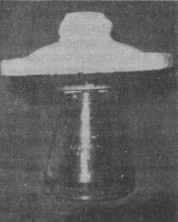
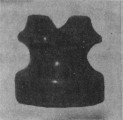
The marking on one side is 1 VICTOR NOV 15 1901 Nothing unusual there, but on
the other side is this one:
PAT NOV. 24 & DEC 15 '96
SEP 97 '97 JUNE 7. '98
May 30 '00 & APR '30 '01
FRED M. LOCKE, VICTOR, N.Y.
All type is non-serif, and the characters in the 4th line are larger than the
other lines. Error #1: That SEP 97 '97 instead of the correct date SEP 28 '97.
Error #2: MAY 30 '00 instead of the correct MAY 29 '00.
Ed Gish
Houston, Texas
- - - - - - - - -
Dear Ed:
Yes, very spectacular, that white shell "Combination".
We'll tag this new Fred marking #6-4. These date errors seem to come only on
the 6-dater and 7-dater stamps of 1901 and later, showing that the plant
personnel were thoroughly confused with Fred's patents by then. But how confused
can you get to think there are 97 days in Sept.?
Jack
Dear Jack:
... During the forties we tested insulators for leakage and patrolled the
Niagara System of Ontario Hydro. The testing (on a dead line, of course) was
done with a meger which had a length of electric cord attached to a bamboo pole.
The pole had a forked copper end. The lineman placed the forked end on each
insulator in turn while the man on the ground cranked the meger. If defective,
the insulator was replaced and listed on a company form.
I recently found an old notebook of mine that listed some of these suspension
insulators. Some were listed by number only, but others had names including:
Canadian Porcelain, Victor, Thomas, Sanitary, Locke, Jeffery Dewitt, Muellers,
Phils (Italian).
I realize suspensions are not as popular with collectors as pin types, but
perhaps some will find this information of some interest.
John D. Clark,
London, Ont., Canada
- - - - - - - - -
Dear John:
Well, at least I find it very interesting. I suppose you also know about
testing suspension disks on live lines with a "buzzing" stick. Maybe
you could say it's being a bit "chicken" to just meg 'em on a dead
line!
This "Duke's mixture" of insulators on a single line or system is
typical of very old lines, not only due to the continual replacements but back
in the days when serviceable equipment was saved and later reused. We have some
old transmission lines west of Phoenix that use large to gigantic multipart pin
types, 4 per pole of course. You can travel the highway for ten miles and never
see two alike. Must be hundreds of different ones on that line. I've seen
similar Duke's-mixture lines throughout the country in my travels, and I'm sure
others have also.
Jack
Jim Allen (Herrin, Ill.) sent in a two-page list of super-goodies he has in
his collection and apologizes for being a "bit late" in getting this
in for the July 1975 collector survey. Well, in the case of reporting all these
gems, it's never too late.
Just ignoring several dozens of items all in the very scarce and rare
categories, here are some selected gems from Jim's list: U-25, U-35, U-401,
U-437A, U-701. Some of these are in the "only couple known" class. He
also has a U-797 O-B Hi-Top in medium blue color.
Jim has always been partial to Illinois items, so it's no big surprise he has
one of the few complete sets of the Illinois dry press with MACOMB marking:
U-42, U-57, U-197A, U-236, U-244, U-244A and U-443.
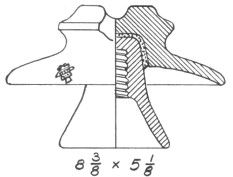
Dear Jack:
I dug this old Locke 2-piece multi about two years ago. Curiosity finally got
the best of me and I had to ask you about it.
It has the Locke #5 marking in your book, an orange brown glaze, Top Rest,
1" pin. Do you know if this is very common, or is it a good collector item?
I also have two P.R. Hats with the Westinghouse incuse stamp #3 stamped twice
on the dome. Have you ever heard of any other Westinghouse with such double
stamping?
I have two other distribution "hats" with radio treated tops. They
have underglaze Whse markings on the skirt. One is brown, the other sky glaze.
I've been a lineman for nearly fifteen years and have seen very few of these on
Massachussettes electric lines. Are they common?
Alan Waugh,
No. Attleboro, Mass.
- - - - - - - - -
Dear Alan:
Your Locke multipart is the #404 cataloged about 1910 and thereafter. Yes,
all of these oldies are good items for the shelf, and any of these types are
getting tough to find. The great majority of them have long since gone to the
dumps as lines were rebuilt with modern components. In some areas there are
still serviceable lines with even older insulators in use, but I fear their days
are numbered. It may be up to what collectors can shelve to keep these types
from becoming extinct, since there is apparently little museum activity in the
preservation of early items used by the electrical power industry.
Yes, it would be unusual for a double striking of the incuse marking on a
single insulator, but certainly not improbable. Not needing an inkpad for this
marking type, a worker might take up to 30 seconds to swat the stamp on
green-trim cart of 200 of them. If he sneezed or even blinked, he could lose his
place and swat a whole row or two a second time -- quicker than he could look to
see where he left off.
You're correct in that radio treated "hat" styles are unusual. The
radio treating is usually a waste of time for voltages under about 6.6 Kv, and
these small styles are usually used for lines of lower voltage. Probably the
only times utilities order them that way is when they have a severe RFI problem
in a given location and are desparate enough to try anything -- whether or not
it will work.
Radio Treated "hats" are known for several of the larger companies
-- notably Thomas, J-D, Westinghouse, Locke, Line Material. Some have RT grooves
only, others with entire groove and crown area treated. The treatment isn't very
noticeable on the brown ones, but it is usually spectacularly pretty on any
light glazes. All are rather scarce as compared with untreated ones.
Lastly, the local Chamber of Commerce is going to slap your hand if you keep
spelling Massachusetts that way!
Jack
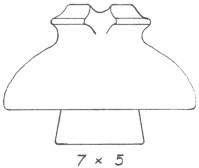
Lew Hohn (Rochester, N.Y.) has the Fred Locke insulator pictured here, and it
has the #6-1 marking. This is a two-piece multipart and was the Locke #103
cataloged in the 1902-05 era. The similar style glazeweld was the #100 and is
U-964 in our chart.
Lew also has a U-675 with a stamp VICTOR JAN. 16 1901 and also yet another
variation of a 4-date stamp as follows:
PAT-NOV 24 & DEC 15 96
SEP 28-97 JUN 7-98
This has all sans-serif letters and numerals of varying size (larger ones
underscored here). There are no periods, commas or apostrophes in this one. The
entire stamp is boldly struck, and there is no trace of a third line -- normally
FRED M. LOCKE, VICTOR, N.Y. Probably there was a third line, but these stamps
all had loose type rows held together in such fashion that one row or another
slipped up on the assembly. This is especially true on the #1-6 thru #1-8 stamps
where either the top or bottom line is missing on many specimens.
We'll tag this new one #4-4 and would like to hear from anyone else having
it, and also if anyone has it with the third line present.
In Feb 1976 CJ (page 40) I said I knew of no other company besides Locke who
made colored Hi-Tops. Lew said, "That'll get you in trouble every time. I
have U-782A, P.P. (cobalt); U-783, P.P. (cobalt); U-786, V-I (cobalt); U-788,
O-B (med. blue). This was one of the first style groups I tried to complete
& I have 50 in all, lacking only U-776A, U-778, U-779 & U-800. I also
have several with RT tops in whites, browns and mottled. It's an impressive and
pretty group to collect."
No, Lew, it didn't buy trouble; it got results. Where were you when we needed
you?

Dear Jack:
In the Feb 1974 CJ list of markings you reported the N. E. E. CO. but showed
it as unattributed at that time. I'm enclosing patent prints and foil
impressions which in combination definitely attribute this marking to New
England Electric Co., Littleton, Colorado.
The first item (not shown here) is a lamp receptacle marked PAT. AUG 27, 1907
/ N.E.E. CO. / 250V 50CP. This fits patent #864,427 of Harry W. Lawrence,
assignor to New England Electric Company.
The second item is this odd "side saddle" nail knob (at right) with
the marking shown above. This is patent #907,251, Dec. 22, 1908, Harry W.
Lawrence, Denver, Colorado.
Upon making quite a few phone calls in the Denver area I found out the
following:
The New England Electric Co. was incorporated in Colorado by Harry W.
Lawrence on Jan. 20, 1900. His patent #864,426 was filed 8-20-06 and gave his
address as Trenton, N.J. His patent #864,427 was filed 1-5-07 with the Denver
address. The company was a Denver-based, wholesale, electrical supply company
first located in the 1700 block of Glenarm Place, later to 1951-53 Lawrence St.,
and in the 1940's to 1312 Broadway. It is still in operation but at 9 Cimmaron
Dr., Littleton, Colorado. It retains the name but no longer deals with anything
electrical. I can not find out who made the porcelain items for them, but it was
not Coors Porcelain in Golden, Colo. They suggest an Eastern U.S. origin, and it
seems plausible that Harry Lawrence probably contracted a porcelain works in the
Trenton area.
Fred Hildebrand,
Lakewood, Colo.
- - - - - - - - -
Dear Fred:
Many thanks for your work in attributing this marking. The original
unattributed marking was from this same "side saddle" knob which I,
Gerald and others have in our collections. I also had the patent #907,251 on it
but couldn't connect Lawrence with Coors Porcelain in Colorado or with any
eastern company, so I was stumped.
You are correct on the eastern origin. I found some of these knobs in the
plant dumpage of Colonial Sign & Insulator Co., Akron, Ohio while studying
that site in 1973. Naturally other companies could also have made these and
other porcelain items for New England Electric.
Jack
Dear Jack:
Recently while going through some National Geographic magazines (1960-62), I
came across this strange pole line setup used in Rumania (see Porcelain Corner
drawing). This apparently was, maybe still is, used in larger cities due to the
many heavy wires & many drop lines going into buildings. With the increase
of foreign insulator interest I had a hunch this would be of some value to
collectors.
The oddest thing here is the use of rods running from the pole through the
crossarms. Also note the stagger method used on the top arm braces. The wires on
the top two arms are larger than those below, and the four large insulators
resemble large "Pogo" styles. All the insulators are white glazed.
Paul E. Mohrs,
Michigan City, Ind.
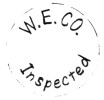
Note the report on page 40 of the Feb 1976 CJ of an insulator with a marking
in the top of the pin hole. Also an incorrect correction (!) of this report in
the April issue that this involved a metal pinhole thimble. Not so.
I've just received one of these from Emma, and the marking is in ordinary
inkpad ink. This one is also legible and indicates this is just an inspector
stamp, most probably applied at the receiving point and not by or at the
factory. Needless to say, the marking easily washes off if you get it wet.
Since this is not a factory applied marking, nor one connected with the
manufacture of the insulator, I would think it would be of little interest to
collectors. Unless one of these turns up in solid 24 Kt gold with inlaid
diamonds for drip points, this is positively the last word that will appear in
this column about this insulator.
| 